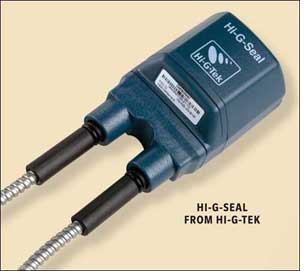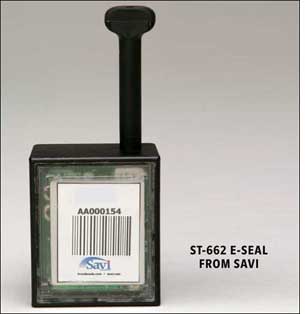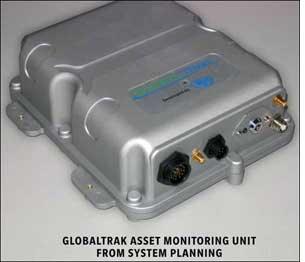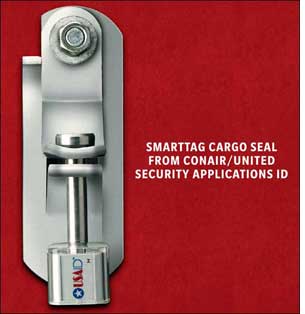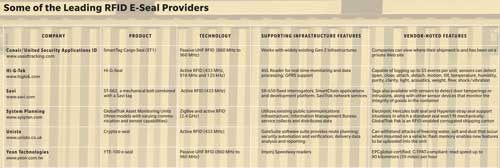Aug 01, 2009Whether you're a manufacturer, logistics provider or port operator involved with the transportation of cargo by ship, rail or truck, you're likely familiar with the practice of securing containers or vehicles with tamper-indicating seals. Today, thousands of available commercial seals—either mechanical or electronic—can indicate whether a door was opened without authorization. But that's where the similarity among these seals ends.
Mechanical seals employ simple bolt or cable-lock mechanisms to obstruct the opening of cargo containers or vehicle doors. While a broken seal makes it obvious that a breach has occurred, it's possible for the bolt or lock to be removed and replaced without the shipper's knowledge.
Electronic seals (e-seals) include physical protection, such as a bolt, as well as a sensor that can monitor for tampering, or some other electronic way to ensure goods are protected. For example, some e-seals can be opened only with a corresponding electronic key received over high-security data links at the destination site. Some can send data about potential tampering and where it might have occurred via a GPS (global positioning system) in combination with satellite or cellular networks, before cargo is loaded into a carrier, en route at sea, and after it arrives at its destination.
More recently, radio-frequency technologies—including active (battery-powered) RFID, passive RFID and ZigBee—have been added to e-seals to provide close-range capabilities. This enables data transmission to interrogators located within distances of just hundreds of feet, affording an alternate way to monitor, say, cargo at rest in a yard or depot. Passive and active e-seals can also be combined with GPS, satellite and cellular services, such as GSM (Global System for Mobiles), so companies can alternate between communications as needed.
There are other differences between standard e-seals and RFID-enabled e-seals. In addition to securing containers, RFID e-seals can speed shipments through the supply chain and increase visibility. Many port operators are likely to have the infrastructure on their gates to support different RFID e-seal technologies. Here's a closer look at the benefits RFID e-seals can deliver.
Cost savings: While RFID e-seals cost more than standard e-seals, they can save money in the long run. Shipping carriers typically have to absorb the costs borne by customs outfits to physically escort containers from yard to yard or from terminal to terminal, as well as inspection fees. RFID e-seals, which provide assurance that cargo hasn't been tampered with, could reduce the number of physical escorts and inspections of containers.
Pilots are planned in Taiwan to make customs clearance as flexible as possible, by applying passive e-seals at technology parks so shippers can exchange information with customs in advance. "If a carrier is ready to go through customs, the carrier can load everything on the truck, and if they provide enough evidence or documentation showing what went on the truck, then seal it with an e-seal and exchange that information with customs, essentially they have done the clearance," says Nancy Tai, president of passive e-seal vendor Yeon Technologies.
Business intelligence: In a closed-loop supply chain, companies can use active RFID e-seals equipped with sensors, which can detect temperature, light, movement and other environmental factors, to obtain information about the location and condition of their cargo. Say, for example, a coffee company is shipping beans from its warehouse in South America to the United States and learns that its shipment is stuck in customs in Costa Rica. If the coffee beans are in danger of deteriorating in the heat, the company can take steps to quickly resolve the issue. Or, if a manufacturer is receiving an excessive number of warranty claims for a product failure, the shipper can see if the sensors recorded any unusual conditions, such as shock impacts. If the event happened while the cargo was in the hands of a third-party carrier, the shipper may be able to get some form of restitution from that provider, or at least it may want to reconsider signing its next contract with that service outfit.
Most organizations are employing simple mechanical seals for two reasons: First, they're cheap, at about $1 each. Second, while RFID e-seals have been recognized for their potential to thwart terrorists in attempts to smuggle nuclear or radioactive materials that could be used in an attack, most governments, including the U.S. Department of Homeland Security (DHS), have stopped short of mandating the use of e-seals for containers.
RFID E-Seal Options
The first question that must be addressed is whether to use a passive or active RFID solution. System Planning's solution, developed in partnership with E.J. Brooks, can support both active RFID and ZigBee; the company says it communicates seal ID and integrity to asset-monitoring units via ZigBee to extend battery life while providing a long communications range.
"In the active-vs.-passive camp, first and foremost, [the issue is the] price, performance, features and functions tradeoff," says Michael Liard, RFID practice director at ABI Research. "The core principles of RFID apply—wireless non-line-of-sight, some type of tamper resistance and evidence information coming in—but [with passive] you may not be able to measure certain things; you're sacrificing some sensor data, for example."
Passive RFID is the less expensive option, running about $5 to $10 (depending on volume) for the e-seal device itself, but it has limitations. Basically, a passive solution will report at the next read point whether a seal appears intact, and nothing more; if tampering has occurred, it can't report any details of that event. But some passive solutions, such as the one from Conair/United Security Applications ID, can be integrated with GPS devices, to provide more frequent shipment tracking. These seals are meant for one-time use; in the case of Yeon's offering, once the piece with the chip and the piece with the antenna have been physically separated, the seal can't be read.
Click here to view a larger version of the above chart.
Passive e-seals conform to the EPC Gen 2 requirements, operating in the 860 MHz to 960 MHz range, and should support the ISO 17712 standard for mechanical seals, which defines mechanical characteristics designed for preventing unauthorized access to cargo containers. There is no international standard that addresses interoperability issues, such as parameters for encoding data beyond the unique ID number in the seal—such as the container number with which it is associated—that could be useful in the supply chain.
Some industry insiders see 433 MHz as the frequency at which most active RFID e-seals will operate; in port environments, the heavy metal of containers and the presence of water and other topographical features present problems for transmission at frequencies of 915 MHz and 2.4 GHz. It's also the frequency mandated by the U.S. Department of Defense and NATO, and major trading countries such as Japan and Korea would prefer to use the 433 MHz frequency for port and customs operations, according to a spokesperson at Savi, a wholly owned subsidiary of Lockheed Martin.

The ISO 18185 standard was designed to provide a basic means of interoperability among read-only, active RFID devices securing cargo containers. ISO 18185, which also requires that the e-seals have the same minimum mechanical characteristics defined by the ISO 17712 standard, is based on Savi Technology's active RFID technology; Savi has licensed that technology to Axcess International, Evigia Systems, Envotech, Identec Solutions, KPC, SAVR Communications and other vendors. ISO/IEC 18000-7:2008 for air interface communications at 433 MHz is the technical standard that defines parameters for active RF networks and active RFID tags used in item management and operating at that frequency. (Most active networks will be based on this standard in the near future, given the large-scale deployments by the DOD and allied militaries, which are the biggest users of active RFID technology in the world, according to Savi.)
Savi notes that e-seals based on ISO 18185 were never developed. The Dash7 Alliance, a new organization initiated by Savi and including its ISO 18185 licensees, is actively pursuing an e-seal standard based on 18000-7 and 17712. The Dash7 Alliance will also address issues such as how sensor data will be treated and transmitted.
Prices for active RFID e-seals can be $100 or more, depending on volume. But unlike passive e-seals, active ones can be reused—if they can be collected in the supply chain—thus lowering the total cost of ownership. Savi says the DASH7 Alliance believes that component costs are poised to decrease due to the new development activities of semiconductor companies, resulting in basic RFID e-seals conforming to 18000-7 and 17712 that will cost less than $20 each, and perhaps significantly less than that amount should high-volume adoption drive costs down even farther.
The e-seal itself is an important piece of a bigger solution for securing and gaining visibility into shipments. Manufacturers may need to invest in RFID interrogators at their own or their contract manufacturers' warehouses and distribution centers, or work with their third-party logistics providers to jointly support the technology and infrastructure they choose. A systems integrator may be needed to supply the applications to support the RFID e-seal processes.
Some vendors can help with facilitating that. Savi Networks, a joint venture between Savi and seaport operator Hutchison Port Holdings, delivers the SaviTrak information service to monitor the location and security status of commercial cargo shipments in real time. System Planning's GlobalTrak, which relies on publicly available global communications networks, has a Web-based Information Management Bureau service that combines information relating to its Asset Monitoring Units with shipping documentation to monitor cargo location and condition in real time.
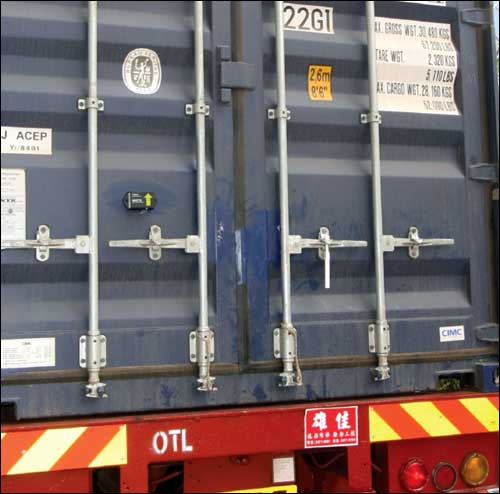
Clearly, RFID e-seals are an emerging market. "There continues to be a lack of true mandates in this space," says ABI's Liard. "Shy of a mandate, this market will grow, but it will be slow."
But it's also an evolving market, as pilots demonstrate how the technology can secure containers and provide real-time information about their locations and conditions, as well as improve port security. Some vendors are leveraging RFID-enabled e-seals to drive other innovations in this area. ODIN Technologies, for instance, recently introduced its SMART Container system, which works in conjunction with its Blackbird Wing to automatically identify the tag of every pallet, case or item that's loaded into—or removed from—the container. ODIN's system won RFID Journal's 2009 Best in Show award, which recognizes the innovative work being done by RFID technology providers (see A Bird's-Eye View).
No doubt, RFID can bring a lot of value to the table—if potential buyers are willing to dig a little deeper to gain the advantages of better security and greater information and visibility.

